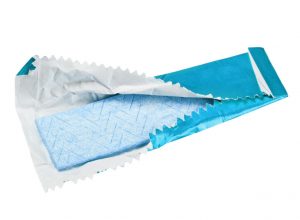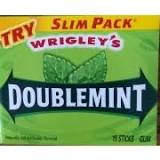
Have you ever wondered how chewing gum is made?
I think it’s interesting, especially when you realize how much it has changed over the decades; a stick of chewing gum has morphed into a purely corporate entity today.
Once upon a time, gum used to be healthy for your gums and teeth – when it was organic, that is.
Chewing exercises your gums and makes them stronger, which in turn, supports healthy teeth.
Today, according to their corporate marketing, when the Wrigley Company makes a stick of chewing gum, it strives for these three main characteristics:

- a smooth, even chew
- a delicious, long-lasting flavor
- dependable, uniform quality
STEP ONE: QUALITY ASSURANCE
All ingredients and wrapping materials are inspected when they arrive at the factories. Before any shipment is accepted, samples are taken and tested in modern quality assurance laboratories.
STEP TWO: GRINDING
Manufacturing takes place in spotless air-conditioned rooms and is closely monitored to meet the company’s high standards of quality. The process begins with the grinding of base materials.
STEP THREE: FILTERING
Next, the base is melted and purified through high-speed centrifuges and filter machines.
Then, when still hot, the base goes to the mixers, each of which can hold up to one ton of ingredients.

STEP FOUR: MIXING
After the gum base is poured into the mixer, sweeteners and flavors are added at just the right moment and in just the right amounts.
The ingredients are then mixed slowly for the exact amount of time required by the formula. At this point, the gum looks like stiff bread dough.
STEP FIVE: ROLLING
Out from the mixers, the gum is sent through a series of rollers that form it into a thin, wide ribbon.
Each pair of rollers is set closer together than the previous pair, gradually reducing the thickness of the gum.
A light coating of finely powdered sugar or chemical sugar substitute is added to keep the gum from sticking and to enhance the flavor.
STEP SIX: SCORING
The continuous ribbon of gum is then scored in a pattern of single sticks.
STEP SEVEN: CONDITIONING
The gum is allowed to cool. The temperature and humidity are carefully controlled to make sure the finished gum will stay fresh on store shelves for an extended period of time.
STEP EIGHT: WRAPPING
The packaging materials are vital in protecting the freshness of Wrigley’s gum.
In one continuous process, the wrapping machine receives and wraps the sticks, applies the outer wrapper, and seals the ends of each package.
Most of the wrapping machines were designed and built by Wrigley engineers and machinists, and each is made up of approximately 6,000 moving parts.

STEP NINE: PACKING
The packages are automatically packed into boxes or clear plastic bags that move on conveyor belts for final inspection.
Boxes are wrapped with a clear covering and both boxes and bags are packed into shipping cases.
Wrigley’s gum is then shipped to hundreds of thousands of stores and other retail outlets all over the world.
Thanks to the Wrigley Company for this detailed explanation.
I think I’d rather chew an old-fashioned organic gum, though. And definitely not one with sugar-free chemicals in the mix.
_____________
If you want to learn more about the diet sweeteners, Join my Private Inner Circle. I have written all about the sugar alcohols in my books on the diet sweeteners.
Gain access to all of my online programs, ongoing support, monthly Q&A, and more by joining my Private Inner Circle Membership Program. I look forward to supporting you on your journey to alternative health and wellness.
_____________
Disclaimer: This article is for informational purposes only, and is educational in nature. The FDA may not have evaluated some of the statements. This article is not intended to diagnose, treat, cure, or prevent any disease. Please discuss with your own, qualified health care provider before adding supplements or making any changes to your dietary program.
Before taking vitamins, consult your doctor; pre-existing medical conditions or medications you are taking can affect how your body responds to multivitamins.